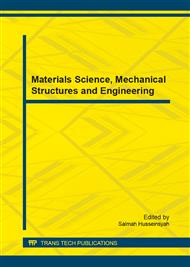p.11
p.15
p.23
p.27
p.32
p.38
p.42
p.46
p.50
Interaction of Purple Sweet Potato Extract with Ascorbic Acid in FeCl3 Solution
Abstract:
Utilization of ascorbic acid as corrosion inhibitor has several weaknesses. These weaknesses are easy to oxidize in solution form and reduction of its antioxidant properties due to heat, light, oxidizing agent, dissolve oxygen, and heavy metals. Purple sweet potato extract is an alternative green corrosion inhibitor with major contains of anthocyanin compound. Anthocyanin will withstand enzymatic reaction and oxidation process of ascorbic acid. Addition of purple sweet potato extract in ascorbic acid will enhance inhibition efficiency of steel compare to the used of ascorbic acid alone. Interaction of purple sweet potato extract with 0.01M ascorbic acid in 0.1M FeCl3 environment was analyzed using FTIR spectroscopy. The result shows that interaction of purple sweet potato extract with ascorbic acid in 0.1M FeCl3 build ability to form iron chelate.
Info:
Periodical:
Pages:
32-37
Citation:
Online since:
October 2014
Keywords:
Price:
Сopyright:
© 2014 Trans Tech Publications Ltd. All Rights Reserved
Share:
Citation:


